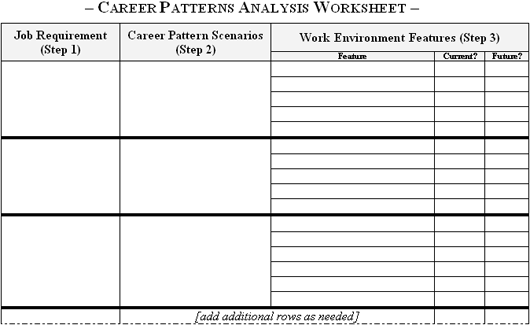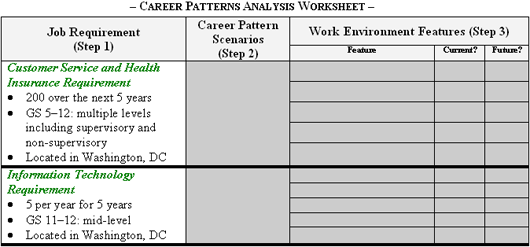Career Patterns Guide
|
Step 1. Define the Job Requirement |
The Analytic Tool: Analysis Process
Watch Interactive Flash Tutorial - Step 1  [864 KB] [864 KB]
Purpose: To understand and define the kinds of employees you want to hire and keep, both short-term and long-term.
Directions:
- Define hiring and retention requirements on the Career Patterns Analysis Worksheet.
- Enter each requirement on a separate row because requirements are best analyzed individually.
- Define the nature and scope of the requirements. Consider defining your requirement using criteria such as:
- Competencies
- Occupational series
- Range of work levels needed
|
- Number of positions/employees needed
- Geographic location
- Timeframe
|



 |
STEP 1 TIPS:
- Break your requirement into smaller components if the nature of the job requirement is significantly different for geographic locations, organizational components, or other subsets of the overall requirement. For example, the requirement to hire program managers may call for a very different Career Pattern Scenario in a remote location than it would in larger metropolitan area.
- Define your job requirement in a way that doesn't reflect past preconceptions or otherwise presume a particular Career Pattern. For example, you should avoid describing your requirement as "entry-level engineers" because you may find upon further analysis that you could better meet your engineering talent needs by targeting Mid-Career Professionals rather than Students or New Professionals.
- Don't complete this step in a vacuum. Your strategic workforce plan should identify your short-term and long-term human capital needs. Make sure you align the job requirements you identify here with your strategic workforce plan. For example, you should be sure to account for workforce needs in all your mission critical occupations.
- It is not necessary to account for every vacancy or position. Instead, summarize or cluster specific job requirements into broader groupings that are similar in nature.
|

Case Study: the Agency for Health Care Administration (AHCA)
Throughout Sections II and III, we will use a case study to illustrate how to use the tool. The case describes some human capital issues the fictitious Agency for Health Care Administration (AHCA) is facing and how AHCA is using the Career Patterns approach to address them. After describing each step, we will show the result of how AHCA used the tool for that step.
Case Study: Human Capital in the Agency for Health Care Administration (AHCA)
AHCA, located in Washington, DC, has an aging workforce with over half its employees eligible for retirement within the next 5 years creating about 200 possible vacancies at all levels. The recent enactment of a new law places a new mandate on the agency that will require a significant increase in customer service and processing of electronic requests for the initial rollout of the program. The level of customer service is expected to decline after the initial roll-out and continue to decline for the next 3 years as customers enroll and gain a better understanding of the benefits program. AHCA's mission focuses heavily on providing a broad range of customer service.
AHCA has also determined a transformation of its information technology capabilities will contribute to more efficient and effective fulfillment of its mission. The agency currently has a limited information technology staff, but not the necessary personnel to lead the IT transformation effort. In addition to IT competence in the areas of computer programming and development, AHCA's requirements include personnel who can plan and execute robust enterprise architecture and can manage the organizational development challenge. There are 25 non-supervisory mid-level vacancies projected over the next 5 years. |
Case Study Step 1: AHCA Defines Job Requirements


|





